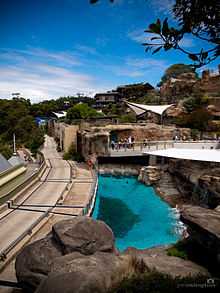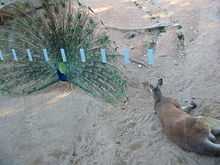
Taronga Zoo lower-level entrance
Taronga Zoo is the city zoo of Sydney, New South Wales, Australia and is located on the shores of Sydney Harbour in the suburb of Mosman. It was officially opened on 7 October 1916. Taronga Zoo is managed by the Zoological Parks Board of New South Wales, under the trading name Taronga Conservation Society, along with its sister Zoo Dubbo's Taronga Western Plains Zoo.
Divided into eight zoogeographic regions, the 21-hectare (52-acre) Taronga Zoo is home to over 2,600 animals of 340 species. It has a zoo shop, a cafe, and information centre.
History

Rustic Bridge in 2009.
The Royal Zoological Society of New South Wales opened the first public zoo in New South Wales in 1884 at Billy Goat Swamp in Moore Park, on a site now occupied by Sydney Boys High School and Sydney Girls High School. Inspired by a 1908 visit to the Hamburg Zoo,[3] the secretary of the zoo, Albert Sherbourne Le Souef, envisioned a new zoo based on the bar-less concept. After realising that the Moore Park site was too small, the NSW Government granted 43 acres (17 ha) of land north of Sydney Harbour. A further 9 acres (3.6 ha) were later granted in 1916.
Taronga is an Aboriginal word meaning beautiful view.[4]
Rustic Bridge
The "Rustic Bridge" was opened in 1915 and was one of Taronga Zoo's earliest landscape features. It was the main way in which visitors could cross the natural gully that it spans. Early photographs show it as a romantic pathway secluded by plantings. The rustic effect was created by embedding stones in the wall and like the Aquarium, its design was reminiscent of Italian grottoes.
Late 1900s
A critical review in 1967 led to a new emphasis on scientific conservation, education and preservation. New exhibits were built starting with the Platypus and Nocturnal Houses, waterfowl ponds and walkthrough Rainforest Aviary. A Veterinary Quarantine Centre was built as was an Education Centre (funded by the Department of Education). Previous attractions such as elephant rides, miniature trains, monkey circus and merry-go-round gave way to educational facilities such as Friendship Farm and Seal Theatre.
In the mid-1980s, a gondola lift was installed that allows visitors to view the zoo and Sydney Harbour. It runs from the bottom of the park close to the ferry wharf, and transports passengers to the top end of the zoo.
2000 master plan
In 2000, TCSA commenced a 12-year $250 million master plan, the majority of which is being spent at Taronga Zoo. The first major master plan item was the Backyard to Bush precinct. Under the plan, the Zoo received five Asian elephants from the Thailand Zoological Park Organisation for breeding purposes, education, long-term research and involvement of conservation programs. The plan has met opposition from environmental activists in Thailand, who blockaded the trucks hauling the elephants to Bangkok International Airport for their flight on 5 June 2006.[5] The elephants along with other Asian rain forest specimens are housed in the "Wild Asia" precinct which opened in 2006 and aims to immerse visitors in an Asian rain forest environment.
A marine section, Great Southern Oceans, opened in April 2008. Recently, the redevelopment and restoration of the historic entrance opened, further adding to the masterplan. The chimpanzee exhibit is also under construction, hoping to split it into two sections, making it easier for introducing new individuals.[6]
Zoo Friends
Zoo Friends offers support in form of volunteers and fund raising for both Taronga and Western Plains Zoo. Members are offered behind-the-scenes experiences at the Zoo and unlimited Zoo entry. Members are also eligible to volunteer to help at the Zoo.
Notable events

Seal Cove Pool with a view to Great Southern Oceans
Platypus birth
In February 2003, it became the second zoo in Australia to breed the platypus.
Australia's first elephant birth

Luk Chai at five months old.
At 3.04 am on 4 July 2009, Thong Dee, an Asian elephant, gave birth to a male calf named Luk Chai. He is the first calf ever born in Australia. Thong Dee, and his father Gung, were two of the eight elephants imported into Australia to participate in the Australasian Conservation Breeding Program.
A further two calves were expected to be born at Taronga in the following two years. The baby elephant is a major tourist attraction, with thousands of visitors attending the zoo just to see him.[7]
Second elephant birth
A baby Asian elephant was thought to have died during labour on 8 March 2010. The calf's 18-year-old mother Porntip was in and out of labour over the week beforehand, after a pregnancy lasting almost two years.
Zoo keepers and veterinarians were concerned about the progress of the labour, with Porntip showing unusual movements and behaviour. An ultrasound revealed that the calf was unconscious in the birth canal, and the zoo announced on 8 March 2010 that the calf was believed to be dead.[8][9] On 10 March 2010 at 3:27 am the male calf was born.[10] It was subsequently named Pathi Harn, a Thai expression meaning "miracle".[11] Pathi Harn's father is Bong Su, of the Melbourne Zoo, and was artificially conceived.
In October 2012, Pathi Harn critically injured his keeper by crushing her against a pole.[12]
Animals and exhibits
Taronga Zoo has about 340 species and over 2,600 individual animals.[13][14] They are housed in a large variety of exhibits, including:
List of animals
Wild Australia
- Australian Wetlands
- Australian Walkabout

A Peacock displays to male Red Kangaroo, 2007.
- Red Kangaroo
- Tammar Wallaby
|
|
|
|
|
- Koala Walkabout
- Platypus House
|
|
- Southern Hairy-nosed Wombat
|
|
- Australian Nightlife
- Red-tailed Phascogale
- Bilby
- Long-nosed Bandicoot
|
- Long-nosed Potoroo
- Brush-tailed Bettong
- Common Ringtail Possum
- Squirrel Glider
|
- Yellow-bellied Glider
- Feathertail Glider
- Greater Stick-nest Rat
- Black-footed Tree-rat
|
|
- New Caledonian Giant Gecko
- Quokka
|
- Australian Rainforest Aviary
- Australian Bush Birds
- Creatures of the Wollemi
- Helmore Parrot Aviary
- Red-tailed Black-Cockatoo
- Yellow-tailed Black-Cockatoo
|
|
|
- Backyard to Bush
|
|
|
|
- Golden orb-web spider
- Huntsman Spider
- Bird-eating spider
- Wolf Spider
- White-tail spider
- Net-casting spider
- Black house spider
- Daddy Long Legs
- Desert Scorpion
- Rainforest Scorpion
|
|
- Other Wild Australia
- Tasmanian Devil
- Red Kangaroo
- Eastern Grey Kangaroo
- Tammar Wallaby
|
|
|
|
|
Great Southern Oceans
- Leopard Seal
- California Sea Lion
|
- Australian Sea Lion
- Australian Fur Seal
|
|
|
Moore Park Aviary
Serpentaria
|
|
|
- Rough Knob-tailed Gecko
- Tuatara
- Reticulated Python
- Amethystine Python
- Green Tree Python
- Boa Constrictor
- Taiwan Beauty Snake
- Rhinoceros Viper
- Eyelash Viper
- Egyptian Cobra
- Corn Snake
- Eastern Diamondback Rattlesnake
|
- Taipan
- Red-bellied Black Snake
- Black-headed Python
- Stimson's Python
- Collett's Snake
- Fierce Snake
- Desert Death Adder
- Broad-headed Snake
- Arafura File Snake
- Star Tortoise
- Elongate Tortoise
- Matamata
- Eastern Snake-necked Turtle
|
|
South American Aviaries
- Brazilian Agouti
- Green-winged Macaw
|
|
|
African Waterhole
- Brazilian Tapir
- Common Zebra
|
|
|
|
Chimpanzee Park
Gorilla Forest
- Western Lowland Gorilla
- Ring-tailed Lemur
Wild Asia
- Asian Elephant
- Silvery Gibbon
- Francois' Langur
- Fishing Cat
- Binturong
- Oriental Small-clawed Otter
- Chital
- Malayan Tapir
- Grey-headed Flying Fox
|
|
|
|
- Koi
- Rosy Barb
- White Cloud Mountain Minnow
- Medaka
|
Himalayan Mountains

Snow leopard showing teeth
Big Cats

Fishing Cat in Taronga (2007)
"Dog Row"
Bear Canyon
Giant Tortoises
Transport

The Taronga Zoo ferry wharf
The Taronga Zoo ferry services are, for many tourists, the preferred mode of travel to the zoo, providing a 12-minute ride from the city to the zoo.[15][16] Passengers disembarking at the ferry wharf, located on Bradleys Head Road, can enter the zoo via a gondola lift or connect with local State Transit bus services. Sydney Ferries offers combined "ZooLink" tickets covering ferry fares, park entry, and gondola ride.
Taronga Zoo also works heavily with various other Sydney Harbour transport operators, such as Captain Cook Cruises and Yellow Water Taxis. Both of these operators offer combined tickets/packages which include tickets covering transport fares, park entry, and gondola ride.
See also
References
- ↑ 1.0 1.1 "Taronga Zoo". zoo.nsw.gov.au. Taronga Conservation Society. Retrieved 27 October 2010.
- ↑ "Zoo and Aquarium Association Institutional Members' Directory". zooaquarium.org.au. Zoo and Aquarium Association. Retrieved 27 October 2010.
- ↑ adb online
- ↑ The Book of Sydney Suburbs, Compiled by Frances Pollen, Angus & Robertson Publishers, 1990, Published in Australia ISBN 0-207-14495-8, page 181
- ↑ National Multimedia
- ↑ Daily Telegraph staff (25 July 2008). "Taronga Zoo's new seal and sea lion show has a messages". The Daily Telegraph.
- ↑ Taronga's New Elephant Calf Takes First Steps Outside Barn, Taronga Conservation Society Australia.
- ↑ "Baby elephant dies during birth at Taronga Zoo". mosman-dailywhereilive.com.au. Mosman Daily. 8 March 2010. Retrieved 20 March 2012.
- ↑ "A mother's heavy burden as baby elephant dies". brisbanetimes.com.au. Brisbane Times. 9 March 2010. Retrieved 20 March 2012.
- ↑ "Sydney's baby elephant 'miracle': he's alive". theage.com.au. Fairfax Media. 10 March 2010. Retrieved 20 March 2012.
- ↑ "Miracle baby elephant gets miracle name". smh.com.au (25 March 2010). 25 March 2010. Retrieved 25 March 2010.
- ↑ Gardiner, Stephanie (19 October 2012). "Woman critically hurt by Taronga elephant". smh.com.au. Retrieved 19 October 2012.
- ↑ "Animal Search". Taronga Conservation Society Australia. Retrieved 7 December 2012.
- ↑ "List of Animals at Taronga Zoo, Sydney". OzAnimals Travel. 2009. Retrieved 7 December 2012.
- ↑ "Taronga Zoo - Mosman". Sydney.com. Retrieved 7 December 2012.
- ↑ Frede, David, A tale of two zoos : A study in watching people watching animals, University of Sydney, Department of Museum Studies, Sydney, August 2007, pp.144-145.
External links










